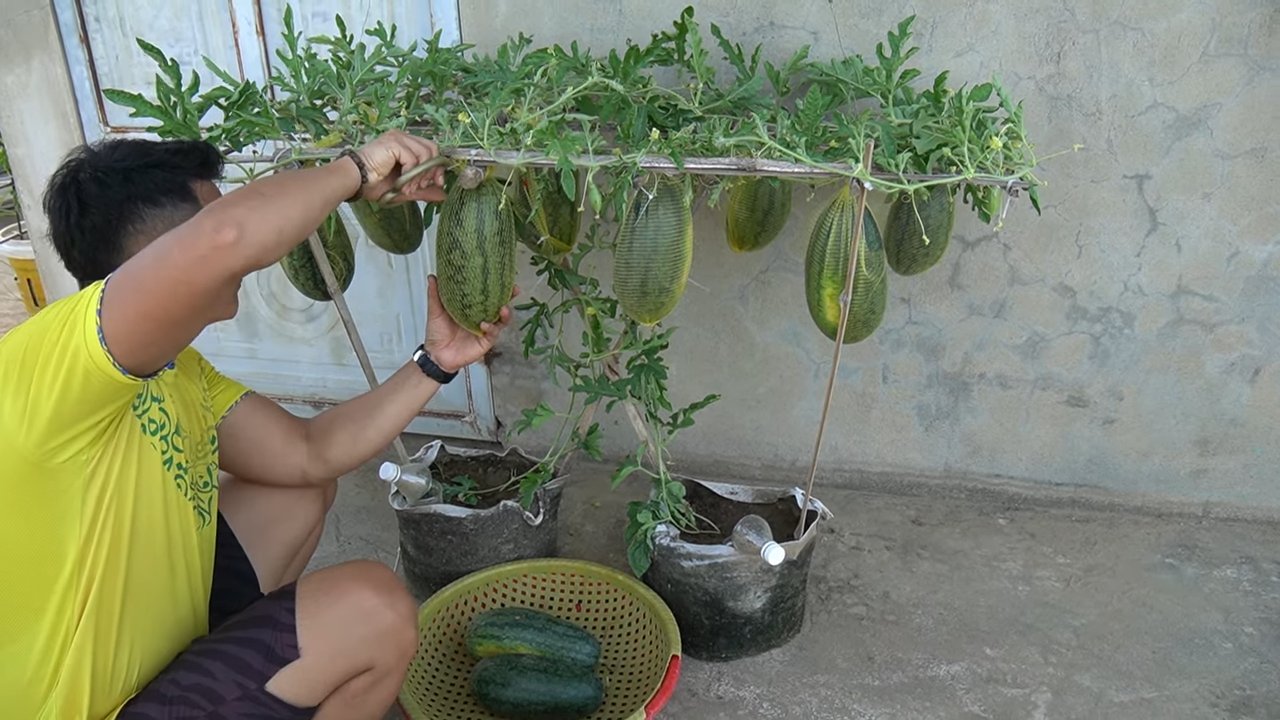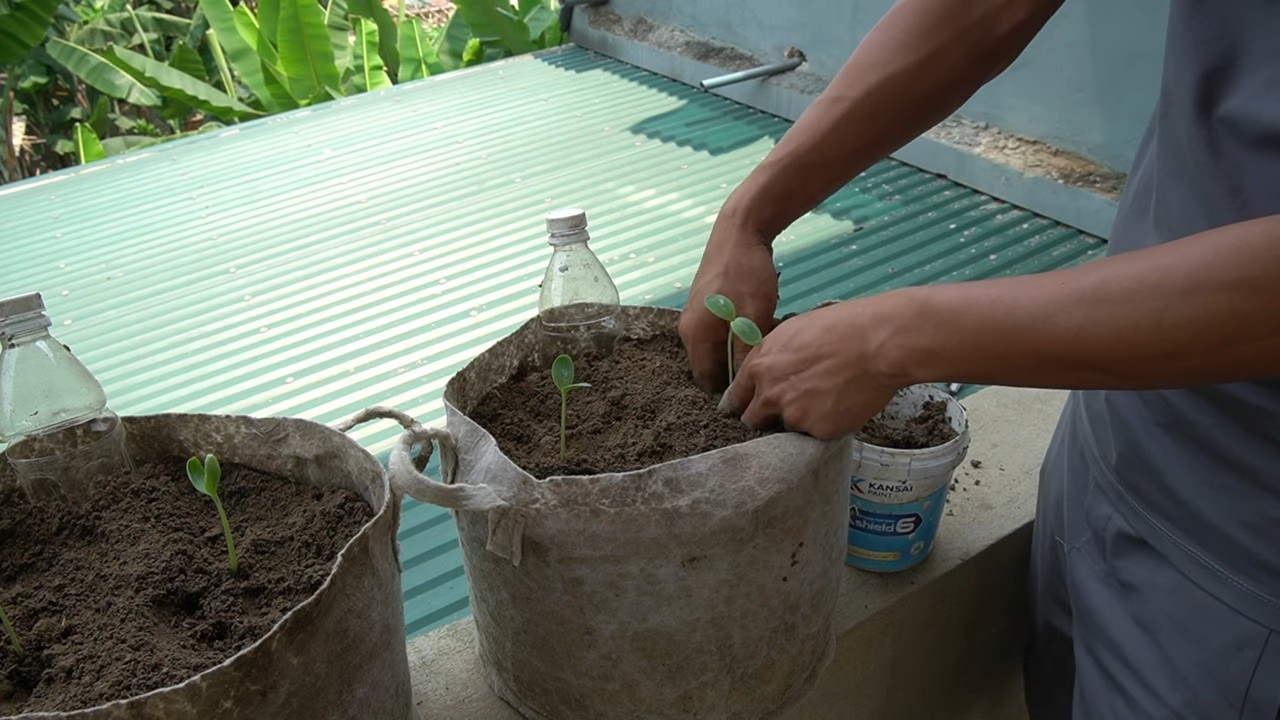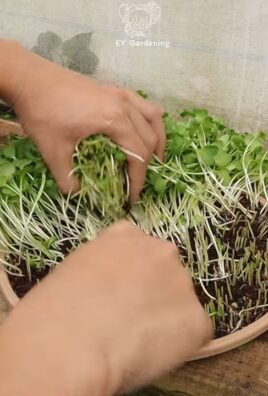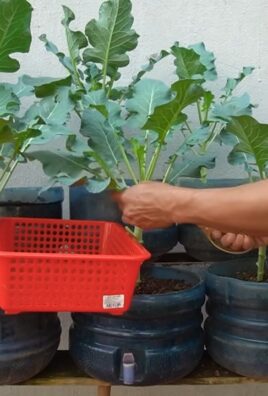Container Watermelon Growing: Imagine biting into a juicy, sweet watermelon you grew yourself, right on your patio! Sounds impossible? Think again! For generations, watermelons were seen as sprawling giants, demanding vast fields. But I’m here to tell you that with a few clever tricks and a little DIY spirit, you can absolutely cultivate these summer delights in containers, no matter how small your space.
The history of watermelon cultivation stretches back thousands of years, with evidence suggesting they originated in Africa. From ancient royalty enjoying them as a refreshing treat to modern-day picnics, watermelons have always been a symbol of summer and abundance. But let’s face it, not everyone has acres of land to dedicate to these beauties. That’s where the magic of container gardening comes in!
Why should you try container watermelon growing? Because it’s incredibly rewarding! It allows apartment dwellers, balcony gardeners, and anyone with limited space to experience the joy of harvesting their own fresh produce. Plus, it’s a fantastic way to control the growing environment, protect your plants from pests, and even extend the growing season. I’m going to share some easy-to-follow DIY hacks that will transform your container watermelon dreams into a delicious reality. Get ready to impress your friends and family with your green thumb – even if you’ve never grown anything before!

Growing Watermelons in Containers: A Step-by-Step Guide
Hey there, fellow gardening enthusiasts! Ever dreamed of biting into a juicy, homegrown watermelon but thought you didn’t have the space? Well, I’m here to tell you that you absolutely can grow watermelons in containers! It’s a rewarding project, and with a little know-how, you’ll be enjoying sweet, refreshing watermelon all summer long. Let’s dive in!
Choosing the Right Watermelon Variety
Not all watermelons are created equal, especially when it comes to container gardening. You’ll want to select a variety that’s compact and well-suited for smaller spaces. Here are a few of my favorites:
* Bush Sugar Baby: This is a classic choice for container growing. It produces small, round watermelons (around 8-10 pounds) on compact vines.
* Sugar Baby: A slightly larger option than Bush Sugar Baby, but still manageable in a large container. Expect watermelons around 10-12 pounds.
* Golden Midget: This variety is known for its early maturity and small, yellow-fleshed watermelons. They’re super cute and delicious!
* Tiger Baby: Another compact variety with striped skin and sweet, red flesh.
* Patio Baby: As the name suggests, this watermelon is specifically bred for container gardening. It produces small, personal-sized watermelons.
Key Considerations:
* Size: Pay close attention to the mature size of the watermelon. You don’t want a vine that’s going to completely take over your patio!
* Days to Maturity: This is the number of days it takes for the watermelon to ripen after planting. Choose a variety with a shorter maturity time if you live in a cooler climate.
* Disease Resistance: Look for varieties that are resistant to common watermelon diseases like powdery mildew and fusarium wilt.
Gathering Your Supplies
Before we get started, let’s make sure you have everything you need. Here’s a checklist:
* Large Container: This is crucial! You’ll need a container that’s at least 24 inches in diameter and 24 inches deep. The bigger, the better!
* High-Quality Potting Mix: Don’t use garden soil! It’s too heavy and won’t drain well. Choose a lightweight, well-draining potting mix.
* Watermelon Seeds or Seedlings: Select your desired watermelon variety. You can start from seed or purchase seedlings from a local nursery.
* Trellis or Support System: Watermelon vines can get heavy, so you’ll need a trellis or other support system to keep them off the ground.
* Slow-Release Fertilizer: This will provide your watermelon plants with a steady supply of nutrients throughout the growing season.
* Watering Can or Hose: Watermelons need consistent watering, especially during hot weather.
* Gardening Gloves: To protect your hands.
* Pruning Shears: For trimming the vines.
* Mulch: To help retain moisture and suppress weeds.
Planting Your Watermelon
Now for the fun part! Let’s get those watermelon seeds or seedlings in the ground.
1. Prepare the Container: Fill your container with the high-quality potting mix, leaving a few inches of space at the top.
2. Sowing Seeds (if starting from seed): Sow 2-3 watermelon seeds about 1 inch deep in the center of the container. Water gently.
3. Transplanting Seedlings (if using seedlings): Gently remove the seedling from its container and loosen the roots slightly. Dig a hole in the potting mix large enough to accommodate the root ball. Place the seedling in the hole and backfill with potting mix. Water thoroughly.
4. Install Trellis or Support: Set up your trellis or support system near the center of the container. This will help the watermelon vines climb and prevent the fruit from sitting on the ground.
5. Mulch: Add a layer of mulch around the base of the plant to help retain moisture and suppress weeds.
Caring for Your Watermelon Plants
Watermelons are relatively easy to care for, but they do have a few specific needs.
1. Watering: Watermelons need consistent watering, especially during hot weather. Aim to keep the soil consistently moist, but not waterlogged. Check the soil moisture regularly by sticking your finger into the soil. If the top inch feels dry, it’s time to water.
2. Fertilizing: Watermelons are heavy feeders, so they need regular fertilization. Apply a slow-release fertilizer according to the package directions. You can also supplement with a liquid fertilizer every few weeks.
3. Pruning: Pruning can help improve air circulation and encourage fruit production. Remove any dead or yellowing leaves. You can also prune the vines to keep them from getting too unruly. I usually trim back the vines that extend far beyond the trellis.
4. Pollination: Watermelons need to be pollinated in order to produce fruit. If you’re growing your watermelons outdoors, bees and other pollinators will usually take care of this for you. However, if you’re growing them indoors or in a greenhouse, you may need to hand-pollinate the flowers. To hand-pollinate, use a small paintbrush to transfer pollen from the male flowers to the female flowers. Female flowers have a small, immature watermelon at the base of the flower.
5. Supporting the Fruit: As the watermelons grow, they can become quite heavy. If you’re growing a larger variety, you may need to provide additional support for the fruit. You can use slings made from pantyhose or netting to support the watermelons and prevent them from breaking off the vine.
6. Sunlight: Watermelons need at least 6-8 hours of sunlight per day. Choose a sunny location for your container. If you don’t have a sunny spot, you may need to supplement with grow lights.
7. Pest and Disease Control: Keep an eye out for pests and diseases. Common watermelon pests include aphids, squash bugs, and cucumber beetles. Common diseases include powdery mildew and fusarium wilt. Treat any infestations or diseases promptly with appropriate organic pesticides or fungicides.
Harvesting Your Watermelon
The moment you’ve been waiting for! Knowing when to harvest your watermelon can be a bit tricky, but here are a few telltale signs:
1. The Tendril: The tendril closest to the watermelon stem will turn brown and dry.
2. The Ground Spot: The spot where the watermelon rests on the ground (or container) will turn from white to yellow.
3. The Thump Test: Give the watermelon a gentle thump. A ripe watermelon will sound hollow.
4. Days to Maturity: Check the seed packet or plant tag for the expected days to maturity. This is a good guideline, but it’s important to use the other indicators as well.
Once you’re confident that your watermelon is ripe, use a sharp knife to cut it from the vine, leaving a few inches of stem attached.
Troubleshooting
Even with the best care, you might encounter a few challenges along the way. Here are some common problems and how to address them:
* Lack of Fruit: This could be due to poor pollination. Make sure you’re hand-pollinating if necessary. Also, ensure your plants are getting enough sunlight and nutrients.
* Small Fruit: This could be due to insufficient watering or fertilization. Make sure you’re watering deeply and regularly, and fertilizing according to the package directions.
* Blossom End Rot: This is a common problem in watermelons, characterized by a dark, sunken spot on the blossom end of the fruit. It’s usually caused by calcium deficiency. To prevent blossom end rot, make sure your soil is well-drained and that you’re providing your plants with adequate calcium. You can add lime to the soil or use a calcium-rich fertilizer.
* Pests and Diseases: As mentioned earlier, keep an eye out for pests and diseases and treat them promptly.
Extra Tips for Success
* Rotate Your Crops: Don’t plant watermelons in the same container year after year. Rotate your crops to prevent soilborne diseases.
* Choose the Right Container: Make sure your container has drainage holes to prevent waterlogging.
* Provide Adequate Support: Watermelon vines can get heavy, so make sure your trellis or support system is strong enough to support the weight of the fruit.
* Be Patient: Watermelons take time to mature. Don’t get discouraged if you don’t see results right away. Just keep providing your plants with the care they need, and you’ll be rewarded with delicious, homegrown watermelons!
Growing watermelons in containers is a fun and rewarding experience. With a

Conclusion
So, there you have it! Growing watermelons in containers might seem like a daunting task, but with the right approach, it’s entirely achievable and incredibly rewarding. This DIY container watermelon growing method opens up the possibility of enjoying homegrown, juicy watermelons even if you’re limited by space. It’s a fantastic way to connect with nature, learn about the growing process, and ultimately, savor the unmatched flavor of a watermelon you nurtured yourself.
Why is this DIY trick a must-try? Because it democratizes watermelon cultivation! No longer is this delicious fruit exclusive to those with sprawling gardens. Apartment dwellers, balcony enthusiasts, and anyone with a sunny patio can now participate in the joy of harvesting their own watermelons. It’s also a sustainable choice, reducing your reliance on commercially grown produce and minimizing your carbon footprint. Plus, let’s be honest, there’s a certain bragging right associated with growing your own watermelon!
But the beauty of this method lies in its adaptability. Feel free to experiment with different watermelon varieties. Smaller, bush-type watermelons like ‘Sugar Baby’ or ‘Bush Sugar Baby’ are particularly well-suited for container growing. You can also explore different soil amendments to optimize drainage and nutrient availability. Consider adding compost tea or worm castings to give your watermelon plants an extra boost.
Don’t be afraid to get creative with your container selection. While a large pot is essential, you can repurpose various containers, such as half whiskey barrels or large plastic tubs, as long as they have adequate drainage. Just remember to ensure the container is sturdy enough to support the weight of the mature watermelon plant and its fruit.
We highly encourage you to give this DIY container watermelon growing method a try. It’s a fun, educational, and ultimately delicious experience. And once you’ve harvested your first homegrown watermelon, we’re confident you’ll be hooked!
More importantly, we want to hear about your experiences! Share your successes, your challenges, and any tips or tricks you discover along the way. Post photos of your container watermelons on social media using [Your Hashtag Here – e.g., #ContainerWatermelon] and tag us [Your Social Media Handle Here – e.g., @YourGardeningAccount]. Let’s build a community of container watermelon growers and learn from each other. Together, we can prove that delicious, homegrown watermelons are within reach for everyone, regardless of their gardening space. So, grab your seeds, your soil, and your enthusiasm, and let’s get growing!
Frequently Asked Questions (FAQ)
What is the best type of watermelon to grow in a container?
The best watermelons for container growing are bush or dwarf varieties. These varieties are bred to be more compact and produce smaller fruits, making them ideal for limited spaces. Some popular choices include ‘Sugar Baby,’ ‘Bush Sugar Baby,’ ‘Golden Midget,’ and ‘Tiger Baby.’ These varieties typically mature faster and require less space than larger, vining watermelons. When selecting your seeds, carefully read the description to ensure it’s a bush or dwarf variety suitable for container gardening.
How big of a container do I need for growing watermelons?
A large container is crucial for successful container watermelon growing. At a minimum, you’ll need a container that is at least 24 inches in diameter and 24 inches deep. A 30-gallon container or larger is even better. The larger the container, the more room the roots will have to grow, and the more water and nutrients the plant will be able to access. Ensure the container has adequate drainage holes to prevent waterlogging, which can lead to root rot.
What type of soil is best for container watermelons?
Watermelons need well-draining, nutrient-rich soil. A good potting mix specifically formulated for vegetables is a great starting point. You can also create your own mix by combining equal parts of compost, peat moss (or coconut coir), and perlite or vermiculite. Compost provides essential nutrients, peat moss or coconut coir helps retain moisture, and perlite or vermiculite improves drainage. Avoid using garden soil, as it can be too heavy and compact for container gardening.
How much sunlight do container watermelons need?
Watermelons are sun-loving plants and require at least 6-8 hours of direct sunlight per day. Choose a location for your container that receives ample sunlight throughout the day. If you live in a particularly hot climate, you may need to provide some afternoon shade to prevent the plants from overheating. Insufficient sunlight can result in poor fruit production and smaller, less flavorful watermelons.
How often should I water my container watermelon plants?
Watermelons need consistent moisture, especially during hot weather and fruit development. Water deeply whenever the top inch of soil feels dry to the touch. Avoid overwatering, as this can lead to root rot. A good rule of thumb is to water thoroughly until water drains out of the drainage holes. Consider using a soaker hose or drip irrigation system to provide consistent and efficient watering.
How do I fertilize container watermelon plants?
Watermelons are heavy feeders and require regular fertilization. Start fertilizing your plants about two weeks after transplanting them into the container. Use a balanced fertilizer (e.g., 10-10-10) diluted to half strength every two weeks. Once the plants start flowering, switch to a fertilizer that is higher in phosphorus and potassium to promote fruit development. You can also supplement with compost tea or worm castings for added nutrients.
How do I pollinate my container watermelon plants?
Watermelons require pollination to produce fruit. If you don’t see bees or other pollinators visiting your plants, you may need to hand-pollinate them. To hand-pollinate, use a small paintbrush to transfer pollen from the male flowers (which have a long, thin stem) to the female flowers (which have a small, immature watermelon behind the flower). Do this in the morning when the pollen is most viable.
How do I know when my container watermelon is ripe?
Determining when a watermelon is ripe can be tricky, but there are a few telltale signs. The tendril closest to the fruit should be brown and dry. The underside of the watermelon (where it rests on the soil) should be a creamy yellow color. And when you thump the watermelon, it should sound hollow. These are good indicators that your watermelon is ready to harvest.
What are some common problems with container watermelon growing and how can I prevent them?
Some common problems include pests (such as aphids and squash bugs), diseases (such as powdery mildew and fusarium wilt), and blossom-end rot. To prevent pests, inspect your plants regularly and treat them with insecticidal soap or neem oil if necessary. To prevent diseases, ensure good air circulation and avoid overhead watering. Blossom-end rot is caused by calcium deficiency, so amend your soil with calcium-rich amendments like bone meal or crushed eggshells.
Can I grow more than one watermelon plant in a single container?
While it’s technically possible to grow more than one watermelon plant in a large container, it’s generally not recommended. Watermelon plants need plenty of space to grow and thrive. Crowding them in a single container can lead to stunted growth, reduced fruit production, and increased susceptibility to pests and diseases. For best results, stick to one watermelon plant per container.




Leave a Comment